|
Bus Oddessy 2001
The overwhelming majority of this information was
derived from Micro Channel Architecture: Revolution in Personal Computing,
by Pat A. Bowlds, pages 135-137. ISBN 0-442-00433-8
Where did you go, Pat?
The beginning- The IBM 1401

All I/O operations controlled are directly by the CPU.
The CPU was also responsible for information transfers to and from memory
or I/O devices. Many processing cycles were consumed with I/O management.
Throughput often limited by the speed of any I/O device, because the CPU
was forced to wait until an I/O operation was completebefore other activity
could begin.
I/O Processor Emerges- IBM System/360
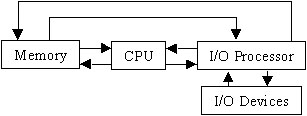
In 1964, the I/O Processor appears (as I do also). This
device boosted performance by allowing the CPU to delegate I/O management
to the I/O Processor by using high level commands. The I/O Processor then
managed all the data transfers between I/O and memory.
The I/O Processor was the ancestor to the channel architecture
used in IBM mainframes. Channels consist of an I/O Processor, multiple
I/O channels and their controllers. They are suitable for mainframe computing
with centralized storage and processing. In addition, the channels can
be cabled across the floor to meet a variety of peripheral requirements.
I/O Devices Use DMA- IBM System/7
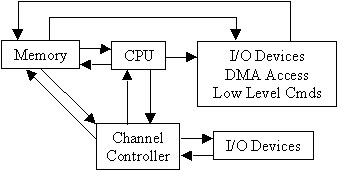
In the early 1970s (my God, that's before some of you
were BORN) the System/7 permitted I/O devices to have DMA. These first
uses of DMA by other devices other than the CPU was the foundation of today's
busmasters.
I/O devices were able to execute low-level commands from
the CPU. The Channel Controller has a similar function to the I/O Processor.
Data transfers from one I/O device to another required
many steps and involved the participation of several parties. At the time,
this resulted in significant performance gains by offloading more work
from the CPU onto I/O devices.
Smart I/O- IBM Series/1
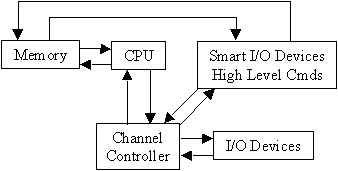
The Series/1 introduced the concept of intelligent adapters
(Smart I/O). These smart I/O devices interpreted and executed their own
commands, which gave them increased independence from the CPU. New software
protocols called Control Blocks were used to permit Series/1 adapters to
access memory directly (called first-party DMA operation) as well as communicate
with the channel controller.
Fall From Grace- IBM AT
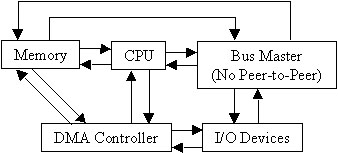
This hell-spawn bus continues to bedevil us with all sorts
of bad mojo. The channel controller was replaced by a DMA controller. The
DMA controller could take control of the I/O bus and act as a third party
in data transfers between devices and memory over multiple DMA Channels.
The AT's MASTER signal introduced the capability of bus
ownership by a Bus Master. This device was given direct memory access using
a single dedicated DMA channel. Problems with the AT implementation of
DMA include: no provision for peer-to-peer data transfer, arbitration by
multiple devices, preemption, and no defined method for equitable bus ownership.
It would have been possible for a bus master to gain control of the bus
and keep other devices from using it. If a bus master did hog the bus,
it would lead to lost data from the loss of memory refresh cycles.
It is possible to design a device and device driver to
prevent these problems, but designers rarely used the AT's MASTER signal.
Supreme Being- IBM PS/2 Microchannel
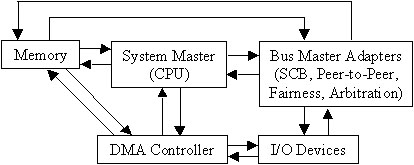
In 1987, IBM blessed the hudled masses yearning for true
busmaster capabilities with MICROCHANNEL.
Unfortunately, IBM seemed to have wanted to rest after that.
True bus master capabilities were finally achieved with
a hardware mediated arbitration process, method of preemption, and a fairness
algorithm for equitable bus sharing.
A new protocol was defined- Subsystem Control Block Architecture,
which provides the proceedures for peer-to-peer communications and data
exchange between masters. SCBs provides a framework for the high level
command capabilities associated with the bus master function.
Busmaster Benefits
Busmasters offload functions from the system master, minimize
interrupts, provide their own processing power, and eliminate third party
DMA transfers. A busmaster goes to the memory or I/O slave (in addition
to other busmasters, of course) and gets the data it's looking for. Sort
of like a 200 pound mouse saying "Here, kitty, kitty".
Bus masters do not necessarily increase system performance.
If the system microprocessor is not busy with other tasks, and is very
powerful, an I/O slave implementation may be faster than a bus master implementation
with a less powerful processor. To Summarize- bus master performance
benefits are observed in systems in which the system microprocessor (or
I/O bus) is busy and near saturation.
Multiple CPU Subsystems
This is interesting for those questing for the "Superserver".
Busmasters can upgrade the processing capability of systems by adding a
new CPU subsystem that serves as a replacement of the system master. The
new CPU subsystem can be given control of the system resources after the
default master has initialized the system. The default master can be made
quiescent, relegated to supporting I/O functions, or operate concurrently
with the new CPU subsystem.
Because multiple bus masters are supported by microchannel,
multiple CPU subsystems can (with the appropriate operating system and
software support) operate concurrently. This concurrent process can provide
significant system processing cababilities without wasting any existing
system logic.
Processor Independence
The added CPU(s) can have a completely different software architectures
from that of their host system. Examples are the adapter for the IBM 6152
Academic System based on the RISC MC68881 CPU with 8MB on-board, Prometa
BusMaster WS/88K, based on the RISC 88000 and running UNIX System V, the
YARC Systems Micro 785+, based on the MC68020 at 40MHz and runs FORTRAN,
C, and Pascal, the Xtend Renaissance CPU board (details are coming, boards
inbound from Canada as of 29 Jun 00), the IBM PS/2 Wizard adapter, based
on the RISC i860 at 33MHz and running numeric intensive calculations (like
a big math-co!) and ending up with the darling of the bunch, the AOX/Kingston
MCMaster, based on a 386 or 486 from 25 to 33 MHz and running whatever
OS you want. Because microchannel architecture is SEPARATE
from the CPU architecture of the system, maximum design flexibility is
achieved.
9595 Main Page
|